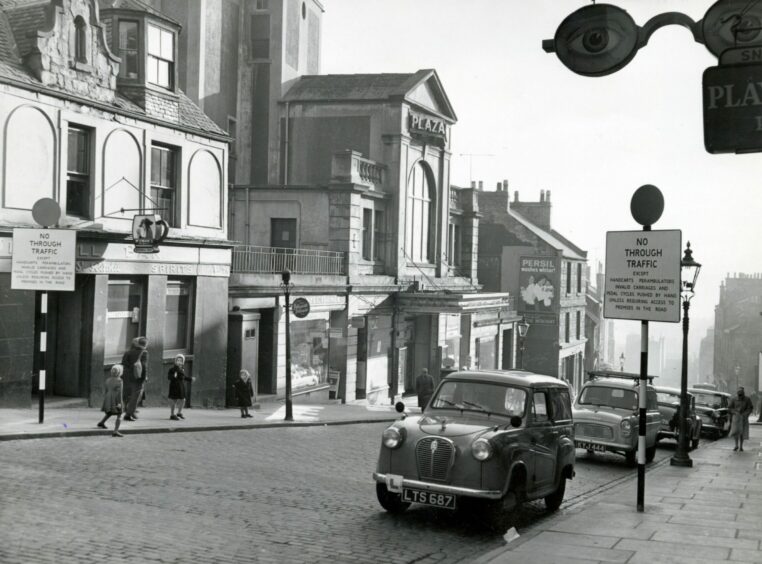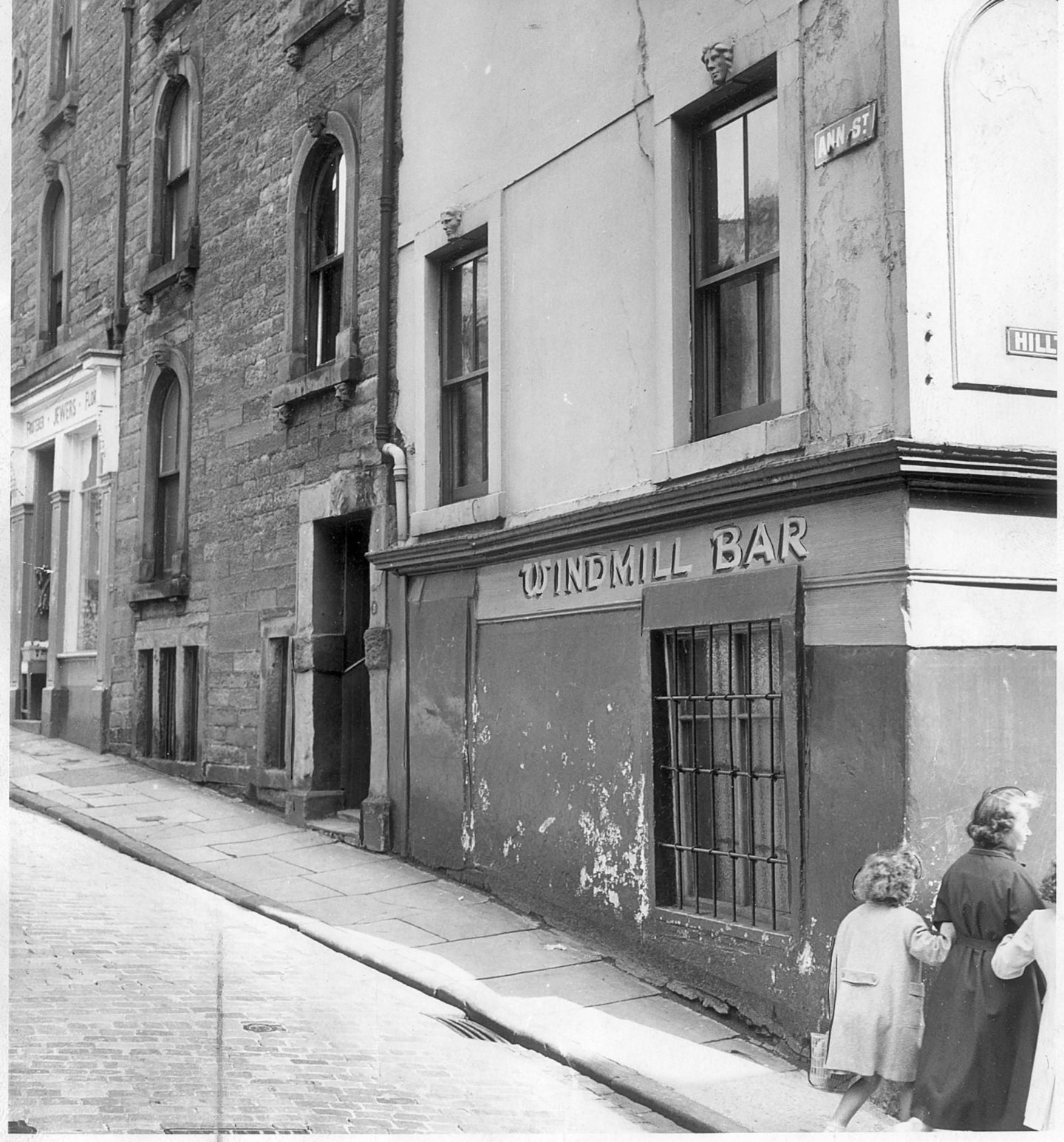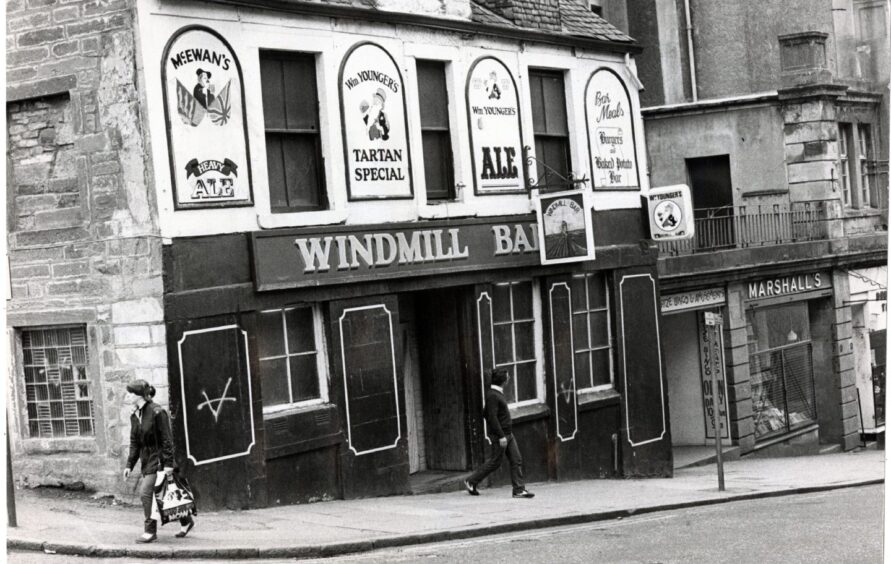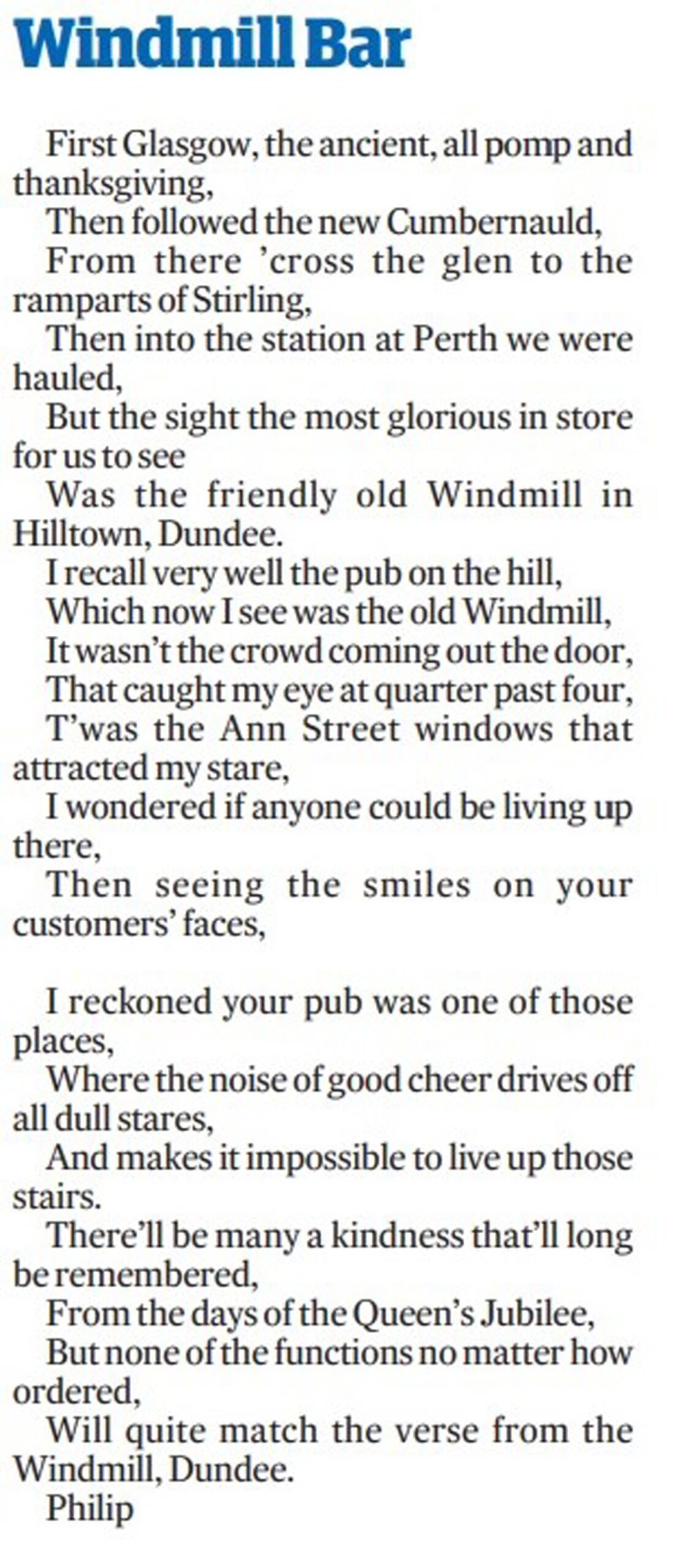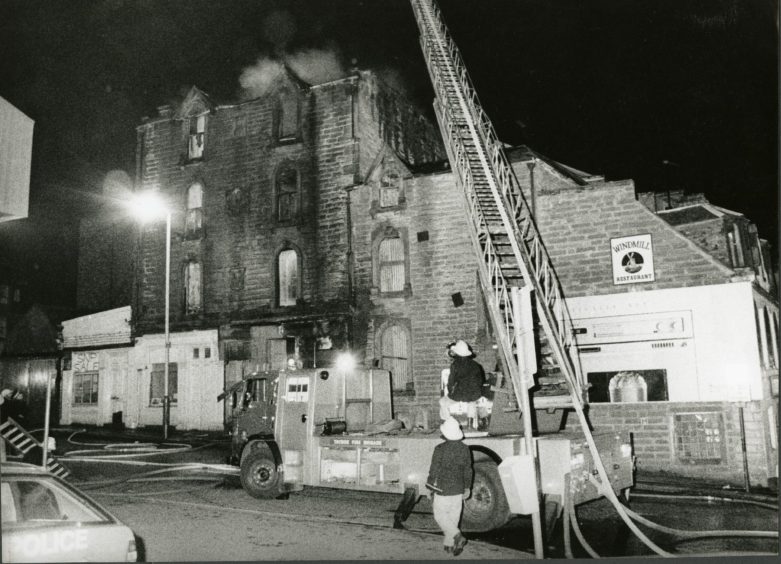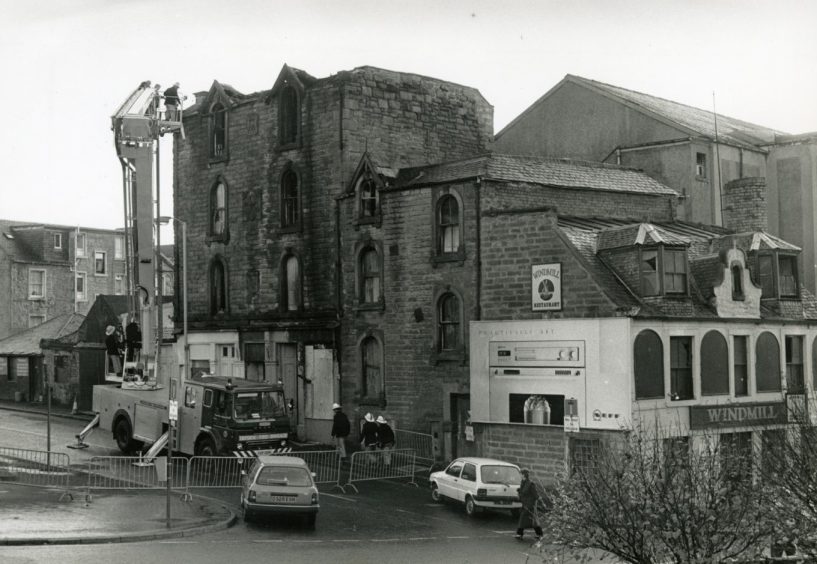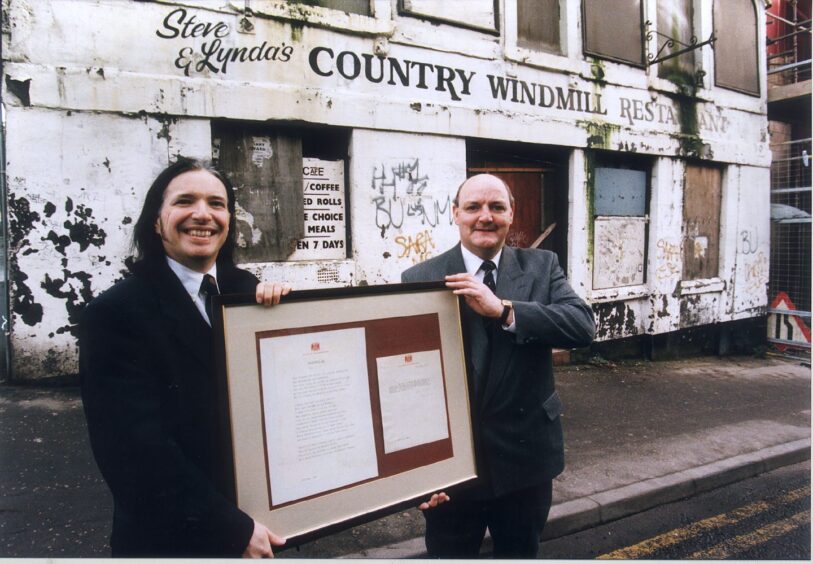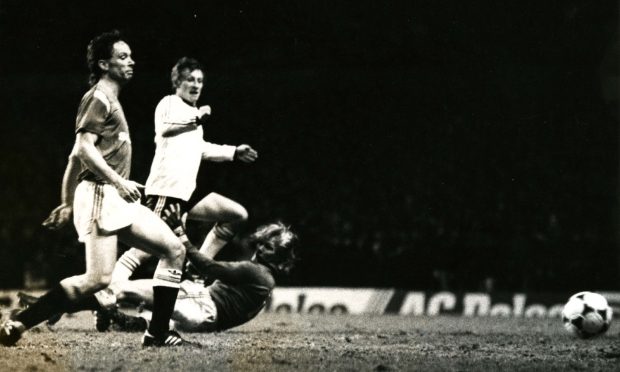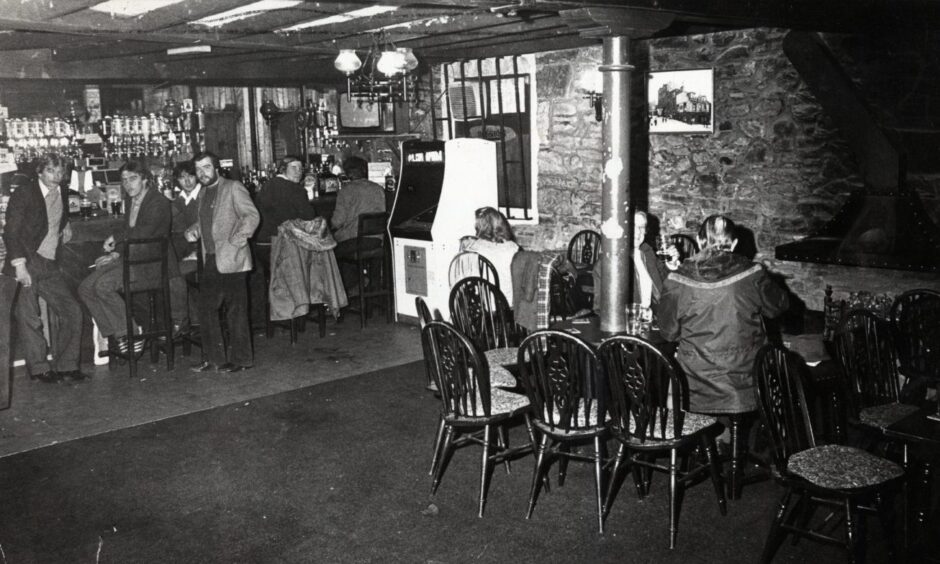
Robin Williams was beloved the world over for his lightning-fast wit and comedic skills – and the punters in one Dundee bar were lucky enough to get front-row bar stools at an impromptu show by the star.
Before Good Morning Vietnam, Dead Poets Society or Good Will Hunting, the comic had drinkers in the Windmill Bar in stitches as he rattled through his repertoire of voices.
And the Oscar-winning megastar was not the only ‘poet’ and famous face to fall for the popular pub.
Prince Philip gave his own royal command performance when he immortalised the Windmill Bar in verse in 1977.
No, we haven’t been in the bar.
The Duke of Edinburgh really did pen an ode to the Hilltown hostelry.
Read on.
Brewing up ales in Rotten Row
A rare urban example of a Georgian (pre-licensing Act) pub, the Windmill Bar in Ann Street was an isolated survivor from the old Hilltown, which was known as Rotten Row.
The area was a barony – a small subdivision similar to a county – in its own right and situated just outside the border of 17th Century Dundee.
In the 1870s, the district of Maxwelltown was acquired by the town from the Maxwell of Tealing family.
Maxwell arranged that new streets be named after his relatives – Ann Street, Eliza Street, George Street, Alexander Street, Elizabeth Street and William Street – all considered part of the wider Hilltown area today.
In the early days the pub was supposed to have brewed its own ale in the cellar.
In a 1970 letter to the Evening Telegraph, a reader said that in a discussion concerning the oldest building in Dundee still serving the purpose for which it was originally built, the building housing the Windmill Bar was reckoned to be it.
“Its quaint casements with their pointed arches, its sphinx-like figureheads, its dormered embrasure which may once have concealed a sniper – all proclaim its antiquity,” he wrote.
“It was probably there when Ann Street was still Skate Row, the fish market of the Barony of Hilltown. Its site was once occupied by the Barony Windmill.
“The dram shop which replaced it evolved into the pub we see today.
“This gives it an age of well over 200 years.
“As a unique architectural curiosity, long may it be spared the ministrations of the bulldozer.”
At the Hilltown end of Ann Street, on its south side, the “sphinx-like figureheads” looked down on the passing populace from above the windows of the Windmill Bar.
They were similar to the four-storey tenement decorated with grotesque animal and human heads which is known as Faces Land at 11-19 North Ellen Street.
The carved masks were placed there in the belief that they warded off evil.
Did they do the trick?
The Windmill Bar stood at the corner of Ann Street for 200 years.
The pub historically had a reputation for being “a bit rough” but peel back the layers and you would find a tight-knit and a welcoming community full of long-term friends.
It was a home from home for all of its regulars.
Robin Williams spoke fondly of the pub
Robin Williams visited it several times during appearances at the Edinburgh Festival in the early 1970s, before he shot to fame.
Williams was staying in cheap digs and became a well-known face at the Hungry Mary’s café where he was particularly fond of Lorne sausage and tattie scones.
Local comedian Bobby Barty invited the young Williams to the Windmill Bar in the Hilltown where he was performing.
In a letter to the Evening Telegraph, Edith Boag said she worked in the Windmill Bar and it was a bit of a novelty having someone from the United States in the pub.
“He came to be in Dundee because he had made friends at the Edinburgh Festival.
“He had cheap digs in Ann Street which were nearly falling down.
“Nobody realised how famous he would become.
“His impressions were great, especially his Scottish accent, which he then used in Mrs Doubtfire.
Robin Williams also liked Dundee pies
“He was always a great comic talent. He told us he liked the ‘old’ buses in Dundee because they were easy to jump off and on, they reminded him of the trams in San Francisco.
“Years later I read in the Tele that readers had spoken to him in Malta harbour during the filming of Popeye, on board one of the old Dundee Fifies.
“That was when he revealed his Dundee connection and, yes, he did like Wallace’s pies!
“What a small world.
“Those were great days and he’s sorely missed.”
Filmed on Malta in 1980, Williams took the title role of Popeye and Shelley Duvall was Olive Oyl in the live-action musical which was partly filmed on board a Fifie.
The MV Scotscraig was the last ferry to make the Tay crossing in 1966 before being moved to Malta where she was billed as the Popeye Barge for the film adaptation.
Another Tele reader recalled bumping into Williams while he was filming Popeye.
“During a break in filming Robin Williams signed autographs and had a laugh and joke with the crowd.
“We mentioned the Dundee connection to him and were surprised to hear that he knew of the city.
“Indeed, he had visited the area several times during appearances at the Edinburgh Festival before he was famous.
“We were even more surprised when he mentioned the Windmill Bar on Hilltown. It was, he said, a rough diamond, but full of characters.”
Prince Philip’s 1977 ode to the Windmill
Prince Philip famously stopped at the bar and pointed up at the windows during the Queen’s jubilee visit to Dundee in 1977, before acknowledging the cheers of the regulars.
In the evening, after the visit, staff and regulars agreed to send a letter to the Duke of Edinburgh about the bar.
They produced three poems on the subject of the bar.
They were copied out on the back of a print of the bar by Fife artist Keith Robson, and handed in to the Queen’s bodyguard at the City Chambers.
Staff and regulars at the bar were amazed some days later to receive a poem in reply.
It was simply titled The Windmill Bar and signed Philip, thanking the regulars for their welcome.
The then-manageress, Mrs Vera McKenzie, said: “We never dreamt we would get a reply.
“It’s marvellous, we can’t get over our poems being answered by another from Prince Philip.
“The regulars are all delighted.”
The poem was framed and mounted on the wall of the Windmill, which became Category B-listed in 1983 after a long battle by Mrs McKenzie, who sadly died just as approval came through.
In November 1988 the “friendly pub on the hill” was almost wiped off the map when a fire ripped through the empty Ann Street building next door around 5pm.
The alarm was raised by customers of the neighbouring Highwayman Bar and flames were already licking the roof by the time the firefighters arrived.
The Courier reported: “Passers-by on their way home from work who stopped to survey the floodlit scene spoke of hearing explosions from inside the building.
“The Hilltown was closed for a short time, with policemen on duty both on the Hilltown itself and on Constitution Street to divert traffic away from the area.
“At the height of the blaze, four fire crews used water jets and a turntable ladder.
“Firemen had to withdraw from the four-storey building shortly before 6pm, as cracks had appeared in the walls and it was feared the structure was in danger of collapse.”
It was.
The Ann Street building was pulled down without ceremony.
The Windmill Bar suffered smoke and water damage but soldiered on for another few years before closing permanently and stood derelict for more than a decade.
A tree was growing out of one of its first-floor windows when a proposal to replace the crumbling building with flats and townhouses was lodged by Discovery Homes in 1998.
The application prompted a campaign to save the building that brought the duke’s old ode to the pub out of safekeeping in February 1999 and to the fore of the bar fight.
Some people were amazed by the level of hype surrounding the derelict building and campaigners were accused of being locked in a “sentimental time warp”.
The campaign gathered pace, however, and Historic Scotland dangled a carrot by suggesting the property be marketed at a “realistically low” price for two months.
No offers were submitted and in August 1999 the category B-listed building was pulled down to make way for the Discovery Homes housing development.
History was reduced to rubble.
